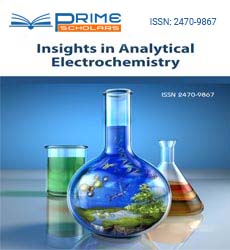Opinion - (2022) Volume 8, Issue 4
Measurement of Natural Biochemical Cycles by Using Biosensor
Hai Wu*
Department of Chemistry and Materials Engineering, Fuyang Normal University, China
*Correspondence:
Hai Wu, Department of Chemistry and Materials Engineering, Fuyang Normal University,
China,
Email:
Received: 29-Jun-2022, Manuscript No. ipaei-22-13726;
Editor assigned: 01-Jul-2022, Pre QC No. ipaei-22-13726(PQ);
Reviewed: 15-Jul-2022, QC No. ipaei-22-13726;
Revised: 20-Jul-2022, Manuscript No. ipaei-22-13726(R);
Published:
27-Jul-2022, DOI: 10.21767/2470-9867-8.4.18
Introduction
The electrochemical biosensor is the insightful gadgets that
transduce biochemical occasions like chemical substrate response
and antigen-immunizer connection to electrical signs
(e.g., flow, voltage, impedance, and so forth). Since Clark fostered
the first adaptation of electrochemical biosensor for
blood glucose, different kinds of biosensor have continuously
been presented and popularized for assorted applications.
A biochemical cycle is the transport and transformation of
chemicals in ecosystems. These are strongly influenced by the
unique hydrologic conditions in wetlands. These processes result
in changes in the chemical forms of materials and also the
movement of materials within wetlands. These, in turn, determine
overall wetland productivity. Materials cycle both within
the wetland and between a wetland and its surroundings.
Few of these processes are unique to wetlands, but some are
more dominant in wetlands than in upland or aquatic ecosystems.
For example, anaerobic conditions are the norm in wetlands,
whereas they are unusual in both terrestrial and aquatic
systems. In this electrochemical biosensor, a cathode is a key
part, which is utilized as a strong help for immobilization of
biomolecules (protein, neutralizer and nucleic corrosive) and
electron development. Different substance adjustment strategies
are applied for this reason by means of amine-and carboxyl
(1-ethyl-3-(3-dimethylaminopropyl) carbodiimide: EDC),
aldehyde-(hydrazine) and thiol (maleimide), contingent upon
the synthetic gatherings on the anode within the sight of or
nonattendance of supporting materials.
Description
Since improper immobilization might cause loss of action, less
explicitness, and low biocompatibility, it is essential not exclusively
to keep up with direction and organic movement of the
biomolecules upon immobilization. Likewise, utilizing legitimate
practical material for the terminal is a vital interaction for
the superior exhibition of biosensors. Measurement of natural
or biochemical cycles are of most extreme significance for clinical,
organic and biotechnological applications. Notwithstanding,
changing the natural data over completely to an effectively handled electronic sign is trying because of the intricacy of interfacing
an electronic gadget straightforwardly to an organic
climate. Electrochemical biosensors give an appealing means
to investigate the substance of a natural example because of
the immediate transformation of an organic occasion to an
electronic sign. Adaptable electrochemical biosensors assume
a significant part in illness determination and medical services
the board. At present, the uses of adaptable electrochemical
biosensors are principally for the recognition of biomarkers
in different body liquids. Also, the adaptable sensors can be
utilized as wearable gadgets for In situ location and long haul
checking of target analyses. In this survey, the agent electrochemical
biosensors including aerometric and potentiometric
biosensors arranged on adaptable substrates and their significant
applications are presented. Then, at that point, we centre
around semiconductor based adaptable biosensors that show
high responsiveness and low recognition limits, which are reasonable
for multiplexing and high-throughput detecting applications.
Conclusion
In this survey, the agent electrochemical biosensors including
aerometric and potentiometric biosensors arranged on adaptable
substrates and their significant applications are presented.
Then, at that point, we centre around semiconductor based
adaptable biosensors that show high responsiveness and low
recognition limits, which are reasonable for multiplexing and
high-throughput detecting applications. Electrochemical biosensors
join the responsiveness of electro analytical strategies
with the intrinsic bio selectivity of the natural part. The natural
part in the sensor perceives it analyse bringing about a synergist
or restricting occasion that eventually creates an electrical
sign checked by a transducer that is relative to analyse focus.
A portion of these sensor gadgets have arrived at the business
stage and are regularly utilized in clinical, ecological, modern,
and rural applications. The two classes of electrochemical biosensors,
bio catalytic gadgets and fondness sensors, will be
talked about in this basic survey to give an available prologue
to electrochemical biosensors for any researcher.
Citation: Wu H (2022) Measurement of Natural Biochemical Cycles by Using Biosensor. Insights Anal Electrochem. 8:18.
Copyright: © Wu H. This is an open-access article distributed under the terms of the Creative Commons Attribution License, which
permits unrestricted use, distribution, and reproduction in any medium, provided the original author and source are credited.

